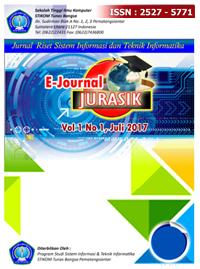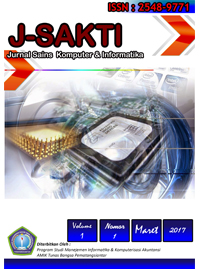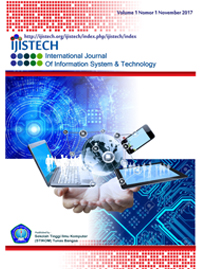Penerapan Clustering dalam Mengelompokkan Jumlah Kunjungan Wisatawan Mancanegara Dengan Metode K-Means
Abstract
Full Text:
PDFReferences
N.Hutasoit, “PENGARUH JUMLAH KUNJUNGAN WISATAWAN MANCANEGARA DAN JUMLAH HUNIAN HOTEL TERHADAP PENERIMAAN SUB SEKTOR PDRB INDUSTRI PARIWISATA DI PROVINSI SUMATERA UTARA TAHUN2004-2013,” Mycol. Res., vol. 106, no. 11, pp. 1323–1330, 2017.
E. G. Sihombing, “Klasifikasi Data Mining Pada Rumah Tangga Menurut Provinsi Dan Status Kepemilikan Rumah Kontrak / Sewa Menggunakan K-Means Clustering Method,” vol. 2, no. 2, pp. 74–82, 2017.
L. Maulida, P. Studi, and M. Informatika, “KUNJUNGAN WISATAWAN KE OBJEK WISATA UNGGULAN DI PROV . DKI JAKARTA DENGAN K-MEANS,” vol. 2, no. 3, pp. 167–174, 2018.
M. G. Sadewo, A. P. Windarto, and D. Hartama, “Penerapan Datamining Pada Populasi Daging Ayam Ras Pedaging Di Indonesia Berdasarkan Provinsi Menggunakan K-Means,” InfoTekJar (Jurnal Nasional Informatika dan Teknologi Jaringan), vol. 2, no. 1, pp. 60–67, 2017.
A. P. Windarto, “Implementation of Data Mining on Rice Imports by Major Country of Origin Using Algorithm Using K-Means Clustering Method,” International Journal of artificial intelligence research, vol. 1, no. 2, pp. 26–33, 2017.
A. P. Windarto, “Penerapan Data Mining Pada Ekspor Buah-Buahan Menurut Negara Tujuan Menggunakan K-Means Clustering,” Techno.COM, vol. 16, no. 4, pp. 348–357, 2017.
M. G. Sadewo, A. P. Windarto, and A. Wanto, “Penerapan Algoritma Clustering dalam Mengelompokkan Banyaknya Desa/Kelurahan Menurut Upaya Antisipasi/ Mitigasi Bencana Alam Menurut Provinsi dengan K-Means,” KOMIK (Konferensi Nasional Teknologi Informasi dan Komputer), vol. 2, no. 1, pp. 311–319, 2018.
DOI: http://dx.doi.org/10.30645/senaris.v1i0.52
Refbacks
- There are currently no refbacks.
 








